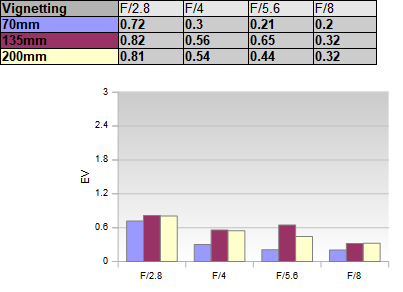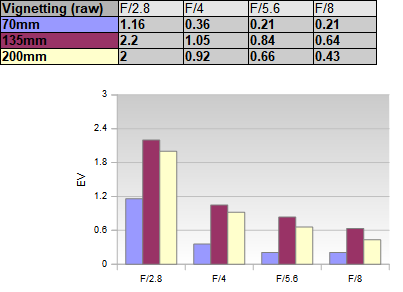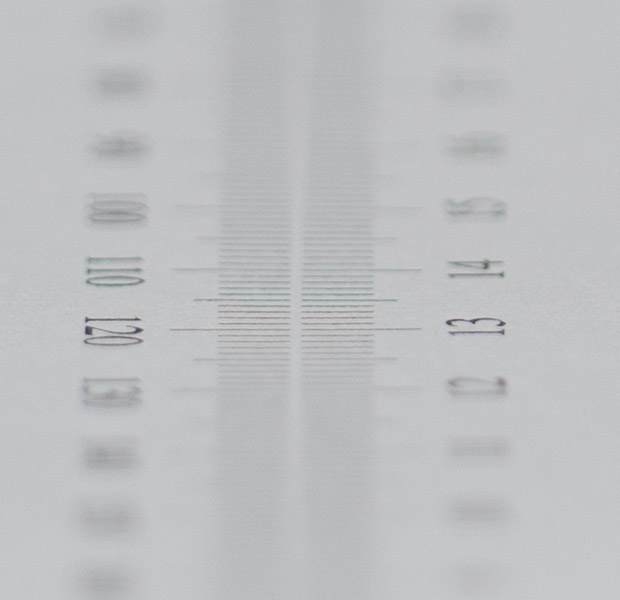|
Sony FE 70-200mm f/2.8 GM OSS (SEL70200GM) - Review / Test Report - Analysis |
|
Lens Reviews -
Sony Alpha (Full Format)
|
|
Page 2 of 3

Distortion
Most users are probably preferring to keep image auto-correction activated all the time.
In this case, distortions are not an issue throughout the zoom range as see below.
When looking at the RAW characteristic, the situation is a little different albeit far from being dramatic.
At 70mm, the lens produces a medium degree barrel distortion (2%). There are barely any distortions in the middle range but
pincushion distortions up to 1.7% show up towards the long end.
Vignetting
Vignetting can also be auto-corrected (at the price of increased corner noise). In this case and at f/2.8, light falloff is still somewhat visible at around 0.8EV (f-stop).
Stopping down reduces the issue slightly.
 If you disable both distortion and vignetting correction, things are different here though. The vignetting is still fairly moderate at 70mm f/2.8 and a non-issue from f/4 here.
However, at 135mm and 200mm @ f/2.8 the light falloff is much more obvious at 2-2.2EV (f-stops). As usual, stopping down to f/4 reduces the vignetting substantially albeit some traces remain even at f/5.6.
If you disable both distortion and vignetting correction, things are different here though. The vignetting is still fairly moderate at 70mm f/2.8 and a non-issue from f/4 here.
However, at 135mm and 200mm @ f/2.8 the light falloff is much more obvious at 2-2.2EV (f-stops). As usual, stopping down to f/4 reduces the vignetting substantially albeit some traces remain even at f/5.6.

MTF (resolution)
We are performing our tests at 42mp and keeping this in mind, the available resolution of the Sony FE 70-200mm f/2.8 GM OSS is impressive. At 70mm the broader center-zone is excellent straight from f/2.8. The borders are very good (just). The corners are just slightly soft at fully open aperture but recover nicely at f/4 already. At 135mm the quality is a bit more even with no weakness of the corners at f/2.8. The center-zone is still tack-sharp at 200mm - surprisingly even a bit better than at 135mm - albeit the quality of the outer image region tanks a little. At f/2.8 the borders are still good whereas the corners are just fair here. Stopping down to medium aperture settings, the corner quality increases to good levels. As usual diffraction effects start having some higher impact from f/11 onward.
The centering quality of the tested sample was Okay albeit not perfect.
Please note that the MTF results are not directly comparable across the different systems!
Below is a simplified summary of the formal findings. The chart shows line widths per picture height (LW/PH) which can be taken as a measure for sharpness.
If you want to know more about the MTF50 figures you may check out the corresponding Imatest Explanations
Chromatic Aberrations (CAs)
The amount of lateral chromatic aberrations (color shadows at the image borders) is pretty good. The CAs remain below 1px on the average at the image borders in the low to mid range - this is rather negligible. The CAs increase slightly at 200mm but they remain unobtrusive at around 1.3px.

Bokeh
Its ability to produce a shallow depth-of-field is a primary selling point of the Sony FE 70-200mm f/2.8 GM OSS. Producing blur is one thing, a good bokeh is another one. However, the Sony lens is showing good skills here.
Out of focus highlights have a perfectly circular shape at f/2.8 and the lens manages to maintain this till f/8. This is unusual and does probably relate to the 11 aperture blades that Sony incorporated. The inner disc zone is fairly clean. On the downside, there's some outlining that is getting emphasized when stopping down.
 Near the borders, the circular discs deteriorate to "cat eyes" as you can see below. This is nothing unusual - it's a vignetting effect - and it can be reduced by stopping down.
Near the borders, the circular discs deteriorate to "cat eyes" as you can see below. This is nothing unusual - it's a vignetting effect - and it can be reduced by stopping down.
 As far as the general background and foreground blur is concerned, it is quite smooth with only minor imperfections at harsher contrast transitions. The best prime lenses may be silkier still but for a zoom lens, the quality is up there with the best in its class.
As far as the general background and foreground blur is concerned, it is quite smooth with only minor imperfections at harsher contrast transitions. The best prime lenses may be silkier still but for a zoom lens, the quality is up there with the best in its class.

Bokeh Fringing
In a perfect world scenario, you won’t see any axial CAs thus color fringing on the Z-axis. However, only a handful of fast lenses are correcting the issue effectively. The Sony FE 70-200mm f/2.8 GM OSS is roughly in line with other lenses in this class. Thus at f/2.8, it shows purplish halos in front the of focus point and some greenish halos beyond. At f/4, the issue is reduced and negligible beyond.
You should also be able to notice that the focus point does NOT shift when stopping down. Many high-speed lenses have difficulties keeping the focus point spot on - focus-shifts or so-called Residual Spherical Aberrations (RSA).
|
Move the mouse cursor over the f-stop marks below to observe the respective LoCAs
|
| f/2.8 |
f/4 |
f/5.6 |
f/8 |
|

|
|